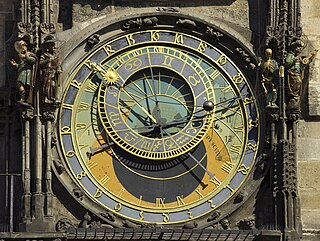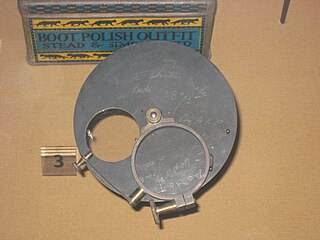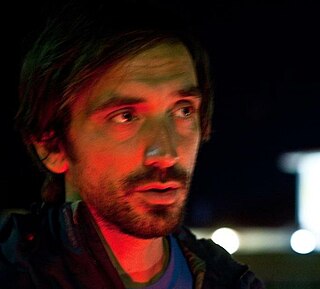
An hour is a unit of time historically reckoned as 1⁄24 of a day and defined contemporarily as exactly 3,600 seconds (SI). There are 60 minutes in an hour, and 24 hours in a day.

Life expectancy is a statistical measure of the estimate of the span of a life. The most commonly used measure is life expectancy at birth (LEB), which can be defined in two ways. Cohort LEB is the mean length of life of a birth cohort and can be computed only for cohorts born so long ago that all their members have died. Period LEB is the mean length of life of a hypothetical cohort assumed to be exposed, from birth through death, to the mortality rates observed at a given year. National LEB figures reported by national agencies and international organizations for human populations are estimates of period LEB.

Clockwork refers to the inner workings of either mechanical devices called clocks and watches or other mechanisms that work similarly, using a series of gears driven by a spring or weight.

Longevity may refer to especially long-lived members of a population, whereas life expectancy is defined statistically as the average number of years remaining at a given age. For example, a population's life expectancy at birth is the same as the average age at death for all people born in the same year.
Underclocking, also known as downclocking, is modifying a computer or electronic circuit's timing settings to run at a lower clock rate than is specified. Underclocking is used to reduce a computer's power consumption, increase battery life, reduce heat emission, and it may also increase the system's stability, lifespan/reliability and compatibility. Underclocking may be implemented by the factory, but many computers and components may be underclocked by the end user.

The Bulldog is a British breed of dog of mastiff type. It may also be known as the English Bulldog or British Bulldog. It is a medium-sized, muscular dog of around 40–55 lb (18–25 kg). They have large heads with thick folds of skin around the face and shoulders, and a relatively flat face with a protruding lower jaw. The breed has significant health issues as a consequence of breeding for its distinctive appearance, including brachycephalia, hip dysplasia, heat sensitivity, and skin infections. Due to concerns about their quality of life, breeding Bulldogs is illegal in Norway and the Netherlands.

The Prague astronomical clock or Prague Orloj is a medieval astronomical clock attached to the Old Town Hall in Prague, the capital of the Czech Republic.

An astronomical clock, horologium, or orloj is a clock with special mechanisms and dials to display astronomical information, such as the relative positions of the Sun, Moon, zodiacal constellations, and sometimes major planets.
A grandfather clock is a tall, freestanding, weight-driven pendulum clock, with the pendulum held inside the tower or waist of the case. Clocks of this style are commonly 1.8–2.4 metres (6–8 feet) tall with an enclosed pendulum and weights, suspended by either cables or chains, which have to be occasionally calibrated to keep the proper time. The case often features elaborately carved ornamentation on the hood, which surrounds and frames the dial, or clock face.
A repeater is a complication in a mechanical watch or clock that chimes the hours and often minutes at the press of a button. There are many types of repeater, from the simple repeater which merely strikes the number of hours, to the minute repeater which chimes the time down to the minute, using separate tones for hours, quarter hours, and minutes. They originated before widespread artificial illumination, to allow the time to be determined in the dark, and were also used by the visually impaired. Now they are mostly valued as expensive novelties by watch and clock enthusiasts. Repeaters should not be confused with striking clocks or watches, which do not strike on demand, but merely at regular intervals.

A striking clock is a clock that sounds the hours audibly on a bell, gong, or other audible device. In 12-hour striking, used most commonly in striking clocks today, the clock strikes once at 1:00 am, twice at 2:00 am, continuing in this way up to twelve times at 12:00 mid-day, then starts again, striking once at 1:00pm, twice at 2:00 pm, up to twelve times at 12:00 midnight.

In photography, a shutter is a device that allows light to pass for a determined period, exposing photographic film or a photosensitive digital sensor to light in order to capture a permanent image of a scene. A shutter can also be used to allow pulses of light to pass outwards, as seen in a movie projector or a signal lamp. A shutter of variable speed is used to control exposure time of the film. The shutter is constructed so that it automatically closes after a certain required time interval. The speed of the shutter is controlled either automatically by the camera based on the overall settings of the camera, manually through digital settings, or manually by a ring outside the camera on which various timings are marked.
Buddhist cosmology is the description of the shape and evolution of the Universe according to Buddhist scriptures and commentaries.

Erinaceus is a genus of hedgehog from the family of Erinaceidae. There are four main species of Erinaceus. The range is all across Europe, throughout the Middle East, parts of Russia, and extending to northern China and Korea. The European hedgehog has been introduced to New Zealand.
The following outline is provided as an overview of and topical guide to life extension:

A turret clock or tower clock is a clock designed to be mounted high in the wall of a building, usually in a clock tower, in public buildings such as churches, university buildings, and town halls. As a public amenity to enable the community to tell the time, it has a large face visible from far away, and often a striking mechanism which rings bells upon the hours.

The history of timekeeping devices dates back to when ancient civilizations first observed astronomical bodies as they moved across the sky. Devices and methods for keeping time have gradually improved through a series of new inventions, starting with measuring time by continuous processes, such as the flow of liquid in water clocks, to mechanical clocks, and eventually repetitive, oscillatory processes, such as the swing of pendulums. Oscillating timekeepers are used in all modern timepieces.

The Montreal Clock Tower, also known as the Sailor's Memorial Clock and Tour de l’Horloge in French, is located in the borough of Ville-Marie and is situated in the Old Port of Montreal. The construction of the tower began in 1919, and was finished in 1922. The Clock Tower is 45 m (148 ft) tall with 192 steps from the bottom to the top of the tower. It has three observation stops along the staircase and is the outside walls of the Clock Tower are white in colour. The structure consists of the principal tower, as well as a smaller tower that is 12 m (39 ft) and architecturally similar to the main tower. The two towers are connected by a white 13 m (42 ft) curtain wall. The tower consists of four translucent clock faces. These are each 3.7 m (12 ft) in diameter and were designed by the English engineering firm, Gillett & Johnston.

Bertrand Planes is a French visual artist who lives and works in Paris, France. His artworks often involve subverting and finding new uses for everyday objects.
This timeline lists notable events in the history of research into senescence or biological aging, including the research and development of life extension methods, brain aging delay methods and rejuvenation.













